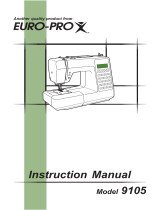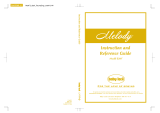
5
— — — — — — — — — — — — — — — — — — — — — — — — — — — — — — — — — — — — — — — — — — — — — — — — — — — —
Setting the Stitch ...............................................................................................................57
Adjusting the stitch width ................................................................................................................................ 57
Adjusting the stitch length ............................................................................................................................... 59
Adjusting the thread tension ............................................................................................................................ 59
Useful Functions................................................................................................................ 61
Automatically sewing reverse/reinforcement stitches....................................................................................... 61
Automatically cutting the thread ..................................................................................................................... 62
Mirroring stitches ............................................................................................................................................ 63
Saving stitch settings ....................................................................................................................................... 64
Useful Sewing Tips ............................................................................................................ 65
Trial sewing .................................................................................................................................................... 65
Changing the sewing direction ........................................................................................................................ 65
Sewing curves ................................................................................................................................................. 65
Sewing thick fabrics ........................................................................................................................................ 65
Sewing hook-and-loop fastener ....................................................................................................................... 66
Sewing thin fabrics.......................................................................................................................................... 66
Sewing stretch fabrics ...................................................................................................................................... 67
Sewing an even seam allowance ..................................................................................................................... 67
UTILITY STITCHES 69
Stitch Setting Chart ...........................................................................................................70
Utility stitches ................................................................................................................................................. 70
Overcasting Stitches.......................................................................................................... 74
Sewing overcasting stitches using overcasting foot "G" .................................................................................... 74
Sewing overcasting stitches using zigzag foot "J" ............................................................................................. 75
Sewing overcasting stitches using the optional side cutter ............................................................................... 76
Basic Stitching ...................................................................................................................78
Basting ............................................................................................................................................................ 78
Basic stitching ................................................................................................................................................. 78
Blind Hem Stitching ..........................................................................................................80
Buttonhole Stitching ..........................................................................................................83
Buttonhole sewing .......................................................................................................................................... 84
Button sewing ................................................................................................................................................. 88
Zipper Insertion .................................................................................................................90
Inserting a centered zipper .............................................................................................................................. 90
Inserting a side zipper ..................................................................................................................................... 92
Sewing Stretch Fabrics and Elastic Tape .............................................................................95
Stretch stitching ............................................................................................................................................... 95
Elastic attaching .............................................................................................................................................. 96
Appliqué, Patchwork and Quilt Stitching ..........................................................................97
Appliqué stitching ........................................................................................................................................... 98
Patchwork (crazy quilt) stitching ..................................................................................................................... 99
Piecing ............................................................................................................................................................ 99
Quilting ........................................................................................................................................................ 100
Free-motion quilting ...................................................................................................................................... 102
Reinforcement Stitching ..................................................................................................103
Triple stretch stitching ................................................................................................................................... 103
Bar tack stitching ........................................................................................................................................... 103
Darning ......................................................................................................................................................... 106
Eyelet Stitching ................................................................................................................ 108
Decorative Stitching ........................................................................................................109
Fagoting ........................................................................................................................................................ 110
Scallop stitching ............................................................................................................................................ 111
Smocking ...................................................................................................................................................... 112
Shell tuck stitching ........................................................................................................................................ 113
Joining .......................................................................................................................................................... 114























